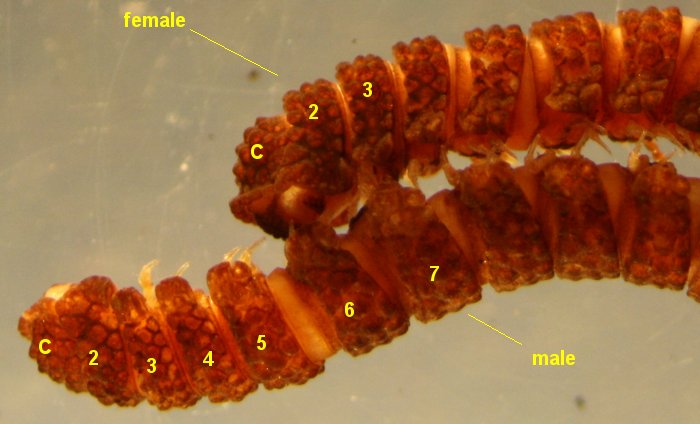Back to: cyphopods
Forward to: coiling
Mating

Prosopodesmus monteithi (Haplodesmidae), Queensland, Australia
Mating is 'face to face' in Polydesmida, but offset by 4 rings. The gonopods on male ring 7 are inserted into female ring 3, as shown above.
Mating Polydesmida are often collected in the field and then preserved, like the pair above, permanently joined. Not many investigators, however, have carefully watched the mating of living Polydesmida. Melissah Rowe (2010) observed 30 copulations in the laboratory involving 19 females of the Australian species Cladethosoma clarum (Paradoxosomatidae). She reported:
When placed in the same mating arena, neither males nor females appeared to be aware of the other sex until physical contact was made. In general, a male initiated mating activity immediately upon physical contact with the female by moving rapidly along her dorsal surface, from posterior to anterior, while tapping his antennae on her body. Upon reaching the anterior region of the female, the male then moved the anterior portion of his body into alignment with the female so that their ventral surfaces were contiguous (i.e. parallel copula position). Specifically, the male positioned the female’s head backward so that his seventh body segment lay opposite the third body segment of the female, allowing the gonopods and vulva to align. While grasping the female’s head with his anterior legs, the male arched his seventh body segment away from the female (presumably to allow ejaculation of sperm from genital openings on the second leg pair onto the gonopods: see Tanabe and Sota 2008). The male then repositioned his body so that the ventral surfaces were again contiguous, inserting his gonopods into the female’s vulva. The male then partially withdrew and reinserted his gonopod into the vulva approximately three times before maintaining continuous ventro–ventro contact for the duration of copulation. No obvious pre- or syn-copulatory courtship behaviour was observed. In contrast to the male, the female did not hold or grasp the male and appeared passive during copulation. Field observations of copulatory behaviour match the description provided here for laboratory experiments.
Copulation in these laboratory trials lasted from 2 to 17 minutes, and averaged just under 5 minutes in this species. Males and females of C. clarum mated several times and with different partners.
Tsutomu Tanabe and Teiji Sota (2008) studied mating in undescribed species of Parafontaria (Xystodesmidae) in Japan. The behaviours of 29 same-species pairs were similar to those described by Rowe, but mating lasted a lot longer:
1. Antennal contact. The male touches the surface of the female body with his antennae.
2. Holding. The male walks along the female’s dorsum and curves the front of his body until the ventral surfaces of both sexes are contiguous. The male then holds the female with his legs... The female’s head is positioned just under the male’s head so that the male gonopods and female genitalia are aligned. The female does not hold the male and appears passive toward the male during mating.
3. Preliminary intromission. The male inserts his gonopods without sperm into the sclerotized entrance cavity of the female genitalia... This stage lasts for 1–4 min. The male gonopods are folded and do not contact the female valvae or receptacle... When preliminary intromission is not accomplished, the male terminates the mating behavior.
4. Ejaculation. When preliminary intromission is accomplished, the male withdraws his gonopods and ejaculates sperm from genital openings on his second legs onto the gonopods by curving his body, with his legs still holding the female... The precise portion of the male gonopods onto which sperm is ejaculated is unknown.
5. True intromission. The male reinserts his gonopods into the female genitalia for insemination. The male gonopods are inserted deep into the female genitalia, with the apical portion of the tibiotarsus and tibiotarsal process of the male gonopods coupled with the female valvae and receptacle. The tip of the tibiotarsus is inserted into a slit in the valvae and receptacle, which is the female genital opening... Sperm appear to be moved through a prostatic groove and transferred from the tip of the tibiotarsus to the female genital opening...
5'. In-out movement phase. Early in true intromission, the male gonopods exhibit a typical in-out movement, which is repeated 10–77 times... and lasts for 6–69 min...
5". Immobile phase. Both sexes are immobile, with male gonopods and female genitalia coupled for 29–215 min...
6. Withdrawal of gonopods. The male withdraws his gonopods to complete mating. The withdrawal of gonopods takes 19–183 s... The entire behavioral mating sequence requires 57–265 min...
For details of genital anatomy, see the gonopods and cyphopods pages. Gonopods are 'charged' with sperm from the gonopores on legpair 2.
Rowe, M. 2010. Copulation, mating system and sexual dimorphism in an Australian millipede, Cladethosoma clarum. Australian Journal of Zoology 58: 127–132.
Tanabe, T. and Sota, T. 2008. Complex copulatory behavior and the proximate effect of genital and body size differences on mechanical reproductive isolation in the millipede genus Parafontaria. The American Naturalist 171(5): 692–699.
Back to: cyphopods
Forward to: coiling
